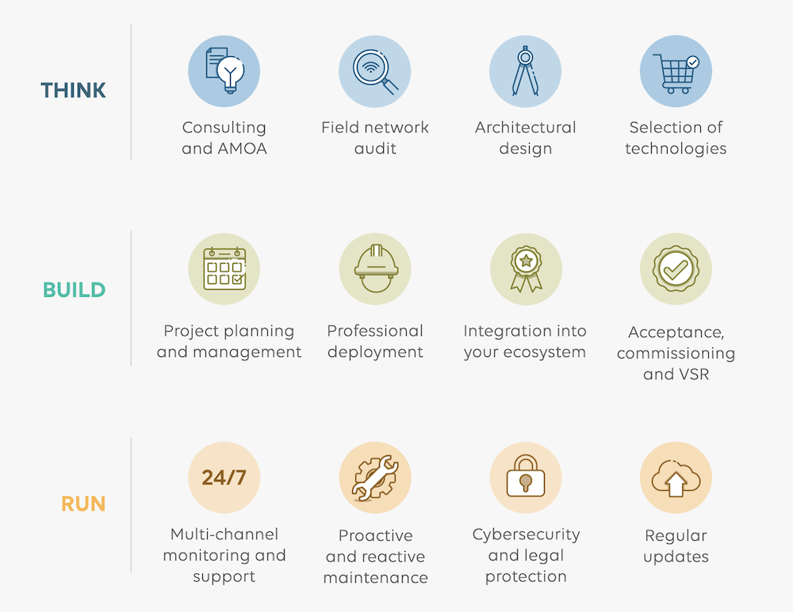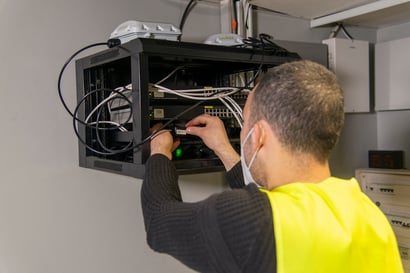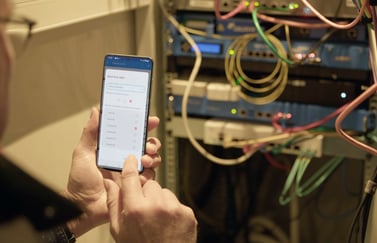WiFi installer, integrator, operator, managed service provider... These are all familiar-sounding words, but they represent distinct roles and entities in a telecoms project. Let's take a look at the missions and skills associated with each of these players, who offer services related to wireless networks but focus on different areas.
A look back at the main phases of a telecoms project
Before getting to the core of the matter, it is essential to understand the main stages in the deployment and life cycle of a WiFi infrastructure. This overview is essential when choosing your service provider — and the associated level of service — to avoid any surprises:

Having a solid and durable professional telecoms infrastructure is not simply a matter of ordering a box and plugging it in as at home. There are key stages, such as auditing and designing the network, that cannot be overlooked. The next decision is whether to take advantage of a provider's technical expertise on an à la carte basis and then operate the service directly, or to outsource network management completely.
WiFi installer / WiFi integrator: the “à la carte” model
A WiFi installer or integrator is a person or company specialising in the installation and configuration of WiFi networks. Their main objective is to deploy equipment in accordance with a layout plan (existing or to be created). They install wireless access points, configure routers, optimise network parameters and carry out coverage tests. They may also contribute to performance and security optimisation. Installers/integrators often work in partnership with equipment manufacturers (which can impact the volume of terminals recommended). Once installation is complete, they no longer operate the network and have no obligation to deliver results in terms of bandwidth or network lifespan. Maintenance, if required, is a separate service and contract.


-
Main advantage
The company retains control of its information system and is not dependent on an external player. It is entirely responsible for its network and everything that passes through it.
-
Main disadvantage
Operating the network in-house means dedicating very large teams to a single project, purely for infrastructure. Maintaining and upgrading a professional infrastructure is also a major challenge. Operating a large-scale, multi-purpose network requires significant tooling and development — capabilities few IT Departments have.
WiFi managed service provider: responsible for delivering the service from A to Z
As its name suggests, a Managed Service Provider supplies Managed Services — the IT network is outsourced. The provider takes full responsibility for managing the business wireless network: first designing an architecture tailored to the customer's needs, then deploying it in accordance with best practice.
 .
. 
Illustration of a post-deployment network test — WaaS model
The provider then assumes full responsibility for service quality throughout the term of the contract, taking preventive or corrective action where necessary.
 .
. 
24/7 network supervision and customer support — by Wifirst
Customers can be sure of benefiting from state-of-the-art equipment and service for the long-term management of their WiFi network. This approach has enabled Wifirst to establish itself as the leader in professional WiFi. Wifirst offers a complete, tailor-made package including audit, design, deployment of a very high quality network (with full site coverage), connection of sites to the core network, AI-driven supervision, site maintenance and upgrades. For example, to reconcile flexibility and security, converging infrastructures and services is now necessary to achieve optimum CSR results. As a managed services provider, Wifirst meets CISO requirements (ISO 27001 certification) while offering customers optimal TTM by enabling new services to be activated on its infrastructures in minutes — possible only with an “as a service” approach.
-
Main advantages
Significant benefits: a specialist operator’s purchasing power on terminals, deep expertise in WiFi technology and evolving standards, and long-term energy and cost savings. The key added value is advice and specialisation that lets IT Departments focus on their core business without worrying about WiFi working everywhere, all the time.
-
Main disadvantage
Some customers may feel they lose control of their information systems by depending on an external player. Careful provider selection and clear governance are essential to build confidence.


